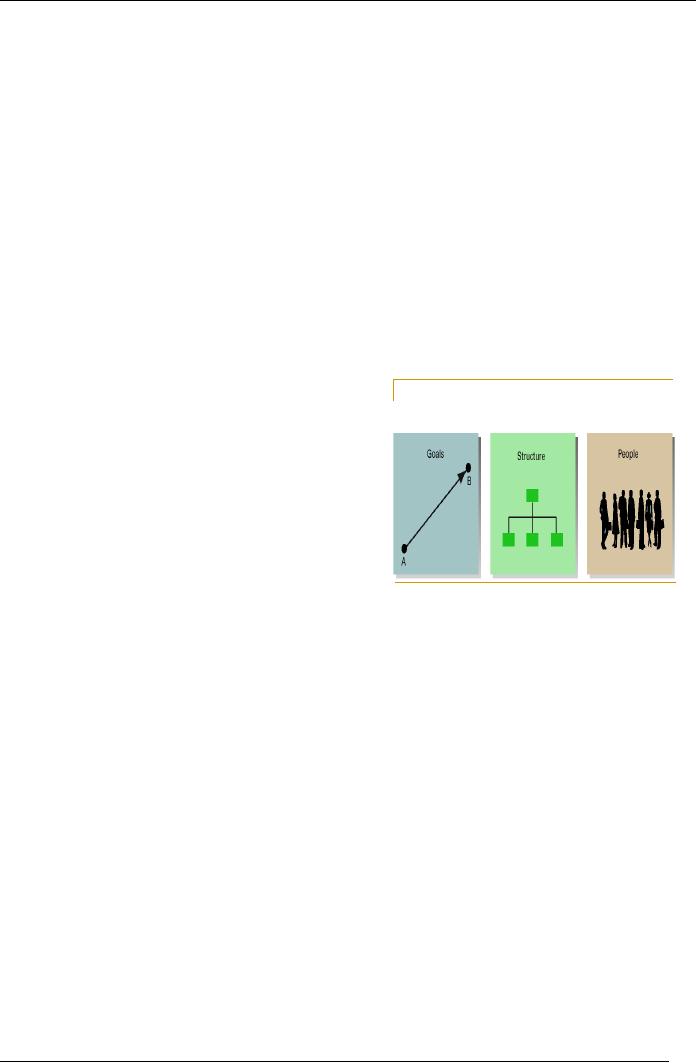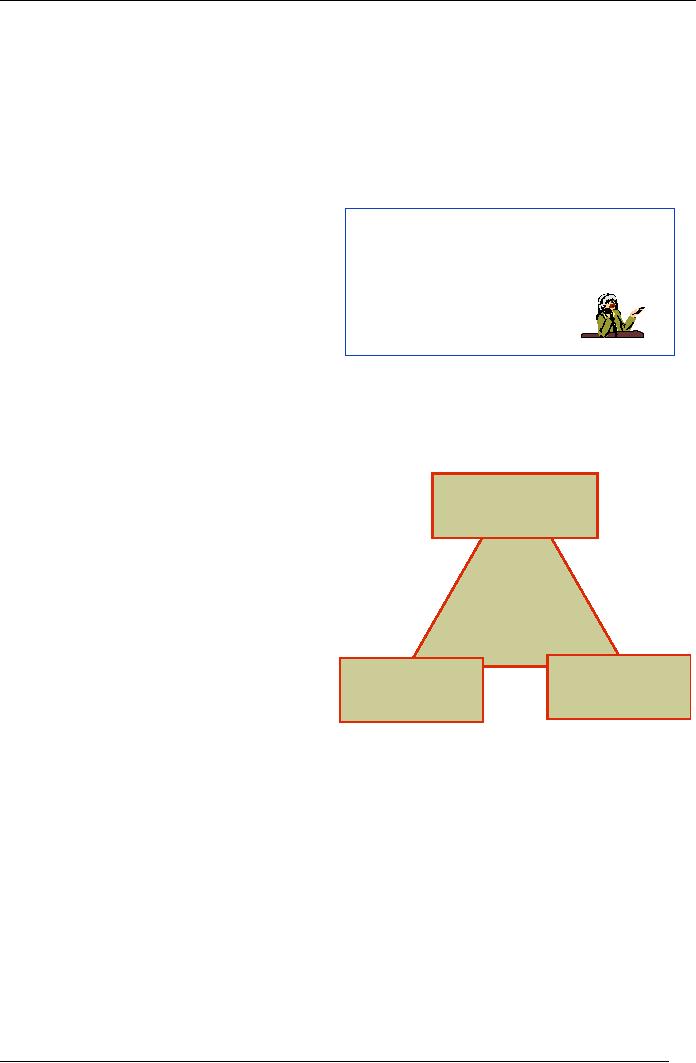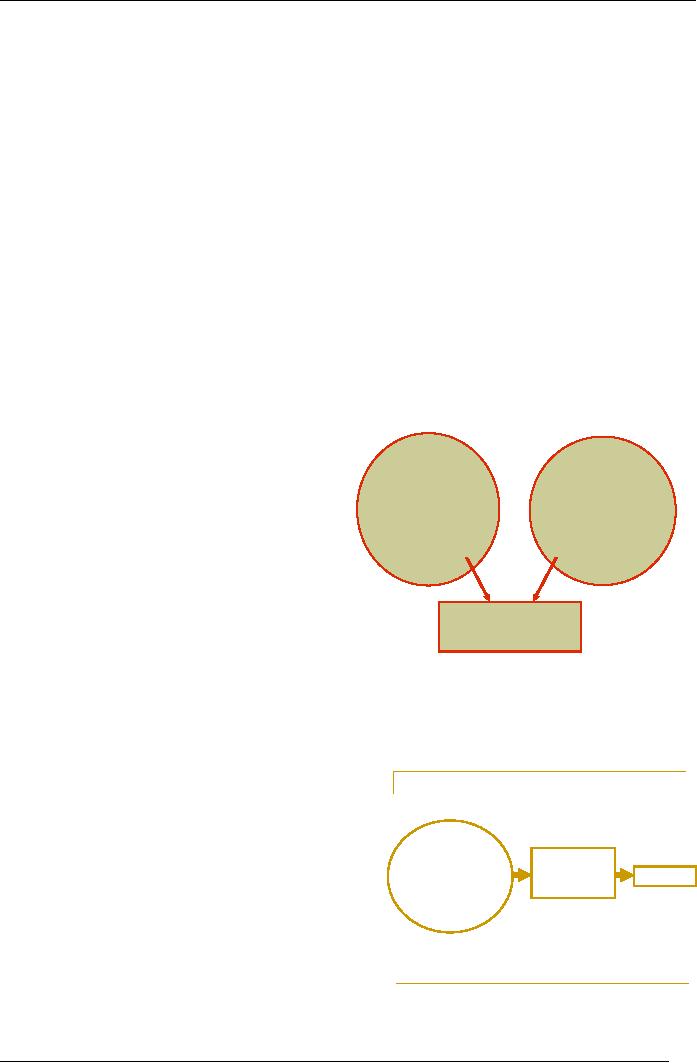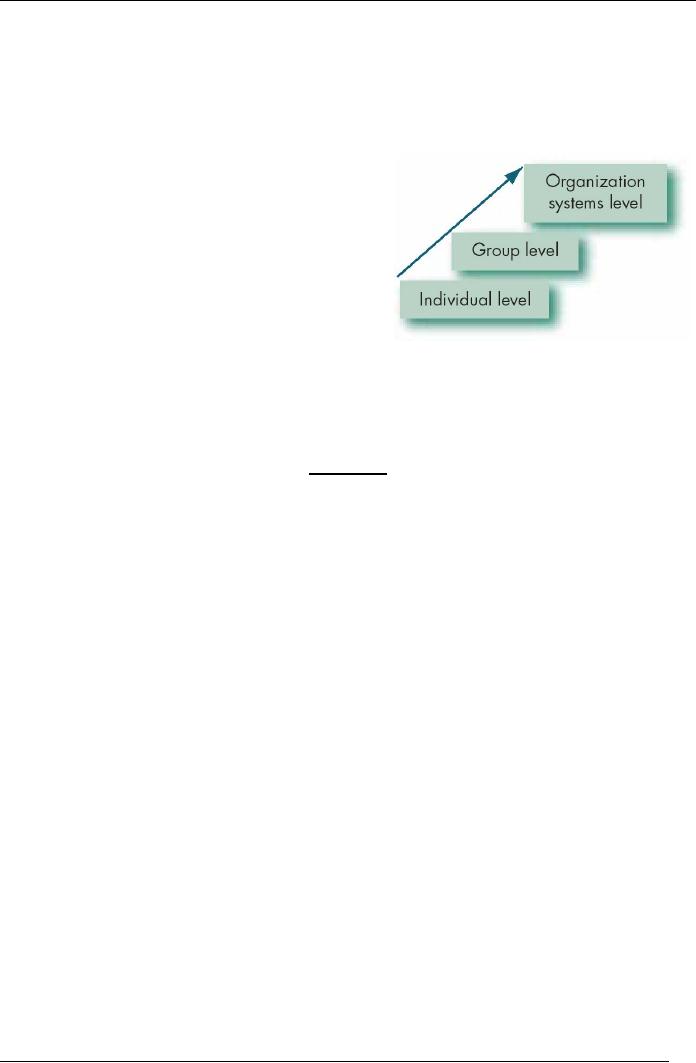 |

Human
Resource Management
(MGT501)
VU
Lesson
4
PEOPLE
AND THEIR BEHAVIOR
After
studying this chapter, students should be
able to understand:
A.
Concepts of people working
together
B.
Organizations and human
behavior
LESSON
OVERVIEW
As
we discussed in the earlier lectures
that human resource
management is the management of human
as
important
resources of organization. Each human is
different from one another.
This difference is due to
the
difference of behavior of each employee. In
order to manage the humans well,
managers need to know
the
behavior of people in order to take the
best out of them. Today we
will be discussing some
basic
concepts
of the Organizational Behavior. We will
have detail discussion on individual
behaviors and the
factors
influencing the individual
behavior.
A.
Concepts of people working
together
Why
to work in organizations?
People
can be more productive when
working in groups than when
working alone. What Managers
can
do
and
what Managers cannot
do
while managing
people,
organizations
and society is the myths of
management.
People
Working Together
Basic
purpose of the working or existence
of
organization
is:
�
Link
individuals into relationships
�
Allocate
the tasks to fulfill the objective
�
Allocate
authority to perform individual
tasks
�
Coordinate
the objectives and activities of
separate
units
�
Facilitate
the flow of work
Organizational
Behavior
�
OB is
concerned specifically with the
actions of
people
at work. Managers need to develop
their interpersonal or people skills if they
are going to be
effective
in their jobs. Organizational behavior
(OB) is a field of study
that investigates the impact
that
individuals,
groups, and structure have
on behavior within an organization, and
then applies that
knowledge
to make organizations work
more effectively. Specifically, OB
focuses on how to
improve
productivity,
reduce absenteeism and
turnover, and increase
employee citizenship and job
satisfaction.
We
all hold generalizations about the
behavior of people. Some of
our generalizations may
provide
valid
insights into human
behavior, but many are
erroneous. Organizational behavior uses
systematic
study
to improve predictions of behavior that
would be made from intuition
alone. Yet, because
people
are
different, we need to look at OB in a
contingency framework, using situational variables
to
moderate
cause-effect relationships.
�
OB
addresses some issues that
are not obvious, such as
informal elements. It offers
both challenges and
opportunities
for managers. It recognizes
differences and helps
managers to see the value of
workforce
diversity
and practices that may
need to change when managing in
different situation and
countries. It
can
help improve quality and
employee productivity by showing managers
how to empower their
people
as well as how to design and
implement change programs. It offers
specific insights to
improve
a
manager's people skills. In times of
rapid and ongoing change,
faced by most managers
today, OB can
help
managers cope in a world of
"temporariness" and learn ways to
stimulate innovation. Finally,
OB
can
offer managers guidance in
creating an ethically healthy work
environment.
Focus
of Organizational Behavior
OB
looks at individual behavior, which
includes personality, perception, learning, and
motivation. It is also
concerned
with group behaviors
specifically in areas of norms
roles, team building, conflicts
and
negotiation.
16

Human
Resource Management
(MGT501)
VU
The
Goals of Organizational
Behavior
1.
The
emphasis will be on employee
productivity, reduce absenteeism,
and turnover.
2.
Organizational
citizenship--a fourth type of behavior
becoming important in determining
employee
performance.
3.
Attitudes
are evaluative statements--favorable or
unfavorable--concerning objects, people,
or events.
4.
An
attitude is made-up of three
components:
cognition,
affect, and behavior.
Components
of Attitudes
5.
The
cognitive component consists of a
person's
beliefs, opinions, knowledge,
and
information
held by a person.
6.
The
affective component of an attitude is the
Cognitive
-- thinking
emotional,
or feeling, segment of an attitude.
7.
The
behavioral component of an attitude
Affective
-- feeling
refers
to an intention to behave in a
certain
Behavioral
-- doing
way.
8.
The
three most important
job-related
attitudes
are job satisfaction, job
involvement,
and
organizational commitment.
Contribution
of OB to effectiveness of
Organization:
Wouldn't
a Manager's job be easier if he or
she could explain and predict behavior?
This is the focus of
organizational
behavior (OB), the study of the actions
of people at work. The goal of OB is to
explain and
predict
behavior of employees at
work.
Understand
OB
focuses on both individual
behavior and
organizational
group
behavior. Managers must
understand
events
behavior
in both the formal and
informal
components
of an organization. Managers are
particularly
concerned with three types
of
Organizational
employee
behaviors: productivity,
absenteeism,
Behavior
and
turnover. A fourth type of
behavior,
Research
organizational
citizenship, is emerging as a
vital
concern.
Predict
Influence
organizational
organizational
Managers
must also be attentive to
employee
events
attitudes.
Attitudes are value
statements, either
events
favorable
or unfavorable, concerning people,
events,
or objects. Attitudes of special
interest to managers pertain to those
related to job satisfaction,
job
involvement,
and organizational commitment. Can you
think of ways in which your
personal attitudes
(values)
have impact on your behavior
at work?
Sometimes
an individual experiences an
inconsistency between two or
more attitudes or between
behavior
and
attitudes. Are happy workers
productive workers? The
answer to this question is not as simple
as it
might
appear. Review the relationship between
employee happiness and
productivity and see what
you
think.
Many researchers now believe
that managers should direct their
attention primarily to what
might
help
employees become more
productive.
Five
specific personality traits have proven
most powerful in explaining
individual behavior in
organizations.
These are locus of control,
Machiavellians, self-esteem, self-monitoring,
and risk propensity.
Review
these traits so you can be
prepared to predict practical work-related
behaviors.
Sometimes
different people will hear or
witnesses the same situations
yet interpret them differently.
This
happens
because of differences in perception. Perception is
the process of organizing and
interpreting
sensory
impressions in order to give meaning to
the environment. Managers need to
recognize that
employees
react to perceptions, not to reality
(if there is such a thing as
"reality"). Thus, managers
must pay
17

Human
Resource Management
(MGT501)
VU
close
attention to how employees
perceive both their jobs
and management
practices.
We
constantly learn from our
experiences. Sometimes we learn
from rewards and punishments
that are a
consequence
of our behavior. We learn to
behave in order to get
something we want or to avoid
something
we
do not want. This is called operative
conditioning. An extension of operant
conditioning is social
learning
theory. Social learning theory
emphasizes that we can learn
through observation as well as
direct
experience.
Managers can influence an employees
learning through the rewards they
allocate and the
examples
they set. Does this advice
seem equally applicable to
parenting?
The
behavior of individuals in groups is
not the same as the sum
total of all of the individuals'
behavior.
Individuals
often act differently in
groups than when they are
alone. This means that
managers must also
understand
the elements of group behavior. This
chapter describes the basic
concepts of group
behavior.
It
is clear that the ability to
understand and predict employee
behavior is a powerful tool
for managers. To
illustrate,
a movie director must often
"get into the mindset" of
characters in a script. Understanding
a
character's
perceptions and motivation
can help the director guide
actors toward an award-winning
performance.
Managers, too, can serve as
a guide and coach, helping
employees meet organizational
goals.
B.
Organizations and human
behavior
Variables
Influencing the Individual
Human Behaviors:
In
simple word behavior is the
function of Person and
Environment in which he/she is
working.
The
following two factors mainly influence
the individual behaviors...
1.
The Persons
2.
The Environment of the
Organization
The
Person
The
PersonsNo
single measure of
individual
The
Environment
�
Skills & abilities
differences
can provide a complete understanding
of
�
Personality
�
Organization
an
individual or predict all the behaviors
of an
�
Perceptions
�
Work group
individual.
It is therefore more useful to consider
a
�
Attitudes
�
Job
variety
of differences that explain aspects
of
�Values
�
Personal life
employee
behavior. These can
be
�
Ethics
�
Skills
& Abilities
�
Personality
Behavior
�
Perceptions
B
= f(P,E)
�
Attitudes
�
Values
�
Ethics
Skills
& Abilities:
Mental
and physical capacities to
perform various tasks. This
comes from knowledge, learning,
and
experiences.
Personality:
Research
has shown five major
dimensions to be
consistent
components of personality. The Big
Five
personality
dimensions
are
conscientiousness,
Personality
extroversion/introversion,
and openness to
experience,
Attitudes
Self-concept
emotional
stability,
and
agreeableness.
Emotions
Behavior
Internal
Conscientiousness
- defined as being reliable and
Abilities
processes
dependable,
being careful and organized,
and being a
Values
person
who plans - is the dimension most
strongly
correlated
to job performance.
Extroversion/introversion
refers to the degree to
which
a
person is sociable, talkative, assertive,
active, and
ambitious.
Openness to experience is the degree
to
which
someone is imaginative, broad-minded, curious,
and seeks new experiences.
Emotional stability is the
degree
to which someone is anxious,
depressed, angry, and
insecure. Agreeableness refers to the
degree to
18

Human
Resource Management
(MGT501)
VU
which
a person is courteous, likable, good-natured,
and flexible. Managers must
remember that the
relevance
of any personality dimension depends on the situation,
the type of job, and the level at which
a
person
is working.
Four
personality traits that have been
consistently related to work-related
behavior are locus of
control,
Type-A
behavior, self-monitoring, and
Machiavellianism. Locus of control
indicates an individual's sense
of
control
over his/her life, the
environment, and external events.
Those with an internal locus
of control
believe
that their actions affect what
happens to them, while those
with an external locus of control
believe
that
outside factors affect what happens to
them. People who exhibit
Type-A behavior try to do
more in
less
and less time in an apparently tireless
pursuit of everything. Type-A people feel great time
urgency, are
very
competitive, try to do many things at
once, and are
hostile.
Self-monitoring,
the fourth personality trait is the
degree to which people are
capable of reading and
using
cues
from the environment to determine
their own behavior. Strong
self-monitoring skills can
help
managers
and employees read
environmental and individual
cues quickly and accurately
and adjust behavior
accordingly.
People with elements of a
Machiavellian personality put
self-interest above the group's
interests
and
manipulate others for personal
gain.
Perceptions:
We
use the mental process of perception to
pay attention selectively to
some stimuli and cues in
our
environment.
There are two types of perception.
Social perception process is the process
of gathering,
selecting,
and interpreting information about
how we view themselves and
others. In contrast,
physical
perception
focuses on gathering and interpreting
information about physical
objects rather than
people.
Closure
permits us to interpret a stimulus by
filling in missing information
based on our experiences
and
assumption.
Attitudes:
Attitudes
are comprised of feelings,
beliefs, and behaviors. One
important work-related attitude is
job
satisfaction,
the general attitude that people
have toward their jobs.
Main five factors contribute
to job
satisfaction:
pay; the job itself; promotion
opportunities; the supervisor; and
relations with co-workers.
The
relationship
between job satisfaction and
work performance is complex and
influenced by multiple
organizational
and personal factors.
Managers have more influence
over job satisfaction than
any other
individual
difference discussed in this
chapter.
Values:
Values
are long-lasting beliefs about what is
important, worthwhile, and
desirable. A person's value
system
is
the way he/she organizes and
prioritizes values. Terminal values
are goals for behavior or
for a certain
result
that someone wants to
achieve. Instrumental values
are the means--the instruments--that
people
believe
they should use to attain their goals.
Cultural values can affect
personal valuesETHICS.
A
key
work-related
value is the employee's ethics.
Those who hold a
relativist's view of ethics
believe that what is
right
or wrong depends on the situation or
culture. Those with a Universalist's
view believe that
ethical
standards
should be applied consistently in all
situations and cultures.
Value conflict occurs when
there is
disagreement
among values that an
individual holds or between individual
and organizational values. To
avoid
value conflict, managers should
work toward integrating and
fitting the values of different
employees
with
the values of the organization.
The
Environment Of Organization
�
Work group
�
Job
�
Personal life
Inside
the organization, the work group or the relationship
between the group members
can affect the
individual
behavior. Organizational culture can also
have impact on the individual
behavior.
Cultural
values indicate what a cultural group
considers important, worthwhile,
and desirable. People
share
the
values of their culture, which
form the basis for
individual value systems
composed of terminal values
and
instrumental values. A key work-related
value is a person's ethics.
Value systems affect ethical
behavior
in
organizations. Managers must be
most concerned with interpersonal
and person-organization value
conflicts.
Interpersonal value conflicts occur
when two or more people have
opposing values, which
can
19

Human
Resource Management
(MGT501)
VU
prevent
co-workers from working together
effectively. Person-organization value
conflicts occur when
someone's
values conflict with the
organization's culture, causing
frustration and possibly
disrupting
personal
performance.
The
factors that influence job
satisfaction are pay; the
job itself; promotion opportunities;
supervisors; and
co-workers.
The link between job
satisfaction and work
performance is complex and influenced by
multiple
organizational
and personal factors. The
link appears to be stronger
for professionals than for
employees at
higher
organizational levels.
The
Basic OB Model
The
basic OB model suggests study of the
organization at
following
three levels:
1.
Organization
2.
Group
3.
Individual
The
purpose of understanding organizations
from all three
levels
(individual, group, and organization) is to develop
a
well-rounded
view that will prepare us
for the challenges that
managers face in today's
business
environment.
Focusing on the individual level allows
us to understand individual differences,
perception,
motivation,
and learning. Focusing on the group level
shows us how more than
two people can work
together
in groups or teams within an
organization. Focusing on the organization level
allows us to see the
effects
of the organizational environment, technology,
strategy, structure, and
culture.
Key
Terms
Organizational
Behavior:
OB
is concerned specifically with the
actions of people at work
Cognitive
component:
The
cognitive component consists of a
person's beliefs,
opinions,
knowledge,
and information held by a
person.
Skills
& Abilities:
Mental
and physical capacities to
perform various tasks. This
comes from
knowledge,
learning, and experiences.
Personality:
The
unique combination of psychological traits
that describes a
person.
OR
behaviors or trends that influence
other people.
Perceptions:
Perception
is the mental process to pay
attention selectively to
some
stimuli
and cues in our
environment.
Attitudes:
Attitudes
are comprised of feelings,
beliefs, and
behaviors.
Values:
Basic
convictions about what is right and
wrong.
Ethics:
Rules
and principles that define
right and wrong
conduct.
20
Table of Contents:
- INTRODUCTION TO HRM:Growing Importance of HRM, Road Map of the Course
- ESSENTIALS OF MANAGEMENT:Concepts and Essential of Management, Manager’s Roles
- ORGANIZATION AND COMPONENTS OF ORGANIZATION:Open versus Closed Systems, The Hawthorne Studies
- PEOPLE AND THEIR BEHAVIOR:Why to work in organizations?, The Goals of Organizational Behavior
- INDIVIDUAL VS. GROUP BEHAVIOR:What Are Roles?, Problem solving Team
- PERSONNEL MANAGEMENT TO HUMAN RESOURCE MANAGEMENT:Records and Administration, Competitive Advantage
- HRM IN A CHANGING ENVIRONMENT:Productivity, New Trends at Work Place
- How organization Cultivate a Diverse Workforce, STEPS TOWARD MANAGEMENT OF DIVERSITY
- FUNCTIONS AND ENVIRONMENT OF HRM:Compensation and Benefits, Safety And Health, Interrelationships of HRM Functions
- LINE AND STAFF ASPECTS OF HRM:Authority, Line versus Staff Authority, Staff Manager
- LEGAL CONTEXT OF HR DECISIONS:Doing the Right Thing, Affirmative Action, Unintended Consequences
- HUMAN RESOURCE PLANNING (HRP):Benefits of HR Planning, Forecasting Human Resource Availability
- STRATEGIC PLANNING AND HRIS:HR’s Strategic Role, Human Resource Information System, Common HRIS Functions
- JOB ANALYSIS:Purposes of the job Analysis, Questions Job Analysis Should Answer
- JOB ANALYSIS:Methods of Collecting Job Analysis Information, Observation, Source of Data
- JOB ANALYSIS (CONTD.):SURPLUS OF EMPLOYEES FORECASTED, Diversity through Recruiting Efforts
- SOURCES OF RECRUITMENT:ALTERNATIVES TO RECRUITMENT, Quantity of the Applicants, Quality of the Applicants
- SELECTION:Initial Screening, Advantages of Successful Screening
- SELECTION TESTS:Characteristics of Properly Designed Selection Tests, Guidelines for Conducting an Interview
- SELECTION PROCESS… CONTD:Background Investigations, Physical Exam, Selecting Managers
- SOCIALIZATION:Compensation and Benefits, Team Membership, Stages in socialization Process, Training and Development Trends
- TRAINING AND DEVELOPMENT:Learning, Phases of Training, Why Transfer of Training Fails
- MAXIMIZING LEARNING:Following up on Training, Repetition, Feedback, Purposes of T & D
- CAREER MANAGEMENT:Individual career planning, Career Planning and Development Methods
- PERFORMANCE:Determinants of Job Performance, Why is performance measured?, Performance Management
- PERFORMANCE APPRAISAL:What to Evaluate, The Appraisal Interview, PROBLEMS IN PERFORMANCE APPRAISAL
- JOB EVALUATION AND PRICING:THE APPRAISAL PERIOD, Ranking method,
- COMPENSATION SYSTEM:Pay, Job Pricing, Compensation: An Overview, Compensation Surveys
- BENEFITS:Total Compensation, Discretionary Benefits (Voluntary), Workplace Flexibility
- ROLE OF MONEY IN PERFORMANCE OF EMPLOYEES:Types of Pay-for-Performance Plans, Empower Employees
- MOTIVATION:The Motivation Process, Motivational Theories, Challenges of motivating employees
- OCCUPATION, HEALTH & SAFETY:Physical Conditions, Accident Investigation, Smoking in The work place
- STRESS MANAGEMENT:Symptoms of Stress, Managing Stress,
- COMMUNICATION IN ORGANIZATION:Burnout, Social Support at Work & Home, Communication in organization, Meetings
- TRADE UNIONS:Collective Bargaining, The HRM Department in a Nonunion Setting, Phases of Labor Relations
- CONFLICT AND NEGOTIATION:Transitions in Conflict Thought, Individual Conflict Management Styles
- POWER AND POLITICS:Sources of Power, Advantages and Disadvantages of PowerPower and Politics in Context
- EMPLOYEE RIGHTS AND DISCIPLINE:Contractual Rights, Management Rights, Disciplining Employees,
- DISCIPLINE (CONT...):Factors to Consider when Disciplining, Disciplinary Guidelines, Employee Separations
- LEADERSHIP:The Leader’s Behavior, Situational Theories of Leadership, Becoming a Leader
- REVISION (LESSON 12-21):Plans, Job Specification, Human resource planning, Selection Process, Corporate Culture
- REVISION (LESSON 22-26):Training, Case Study Method, Training, Performance
- REVISION (LESSON 27-35):Classification Method, Compensation, Empowerment, Mediation
- INTERNATIONAL DIMENSIONS OF HRM:Global Corporation, Type of staff members, Approaches to Global Staffing
- CONCLUSION & REVIEW:Strategies for Gaining Competitive Advantage, High-performance Work System